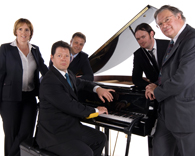- Home
- SCALERAIL
- Scales
- Exercises
- Simple - Elegant - Effective!
- About us
- News & information
- For Teachers
- Courses & seminars
- School & institutions
- Recommended exercises and repertoire
- For Parents
- Articles & advice
- Glossary of Terms
- Adult learners
- For Students
- Practice advice and help
- Glossary of Terms
- SCALERAIL videos
- Lessons (PDF)
- Distributors
- Contact Us
- Privacy Policy
There are many collections of technical exercises
available for the pianist to use today. Many of them were written by pedagogues of past generations and have always had pianists and teachers ready to recommend them.
Some are less well known but contain very useful material that is well worth investigating. Many make effective teaching material when used as part of a progressive course of study. It is important to remember that all material used in your teaching should be evaluated thoroughly before it is introduced to your students.
Purpose
What is the exercise designed to achieve?
Suitability
Does it meet the student's present need?
Evidence
Does your experience provide evidence that the exercise can achieve its intended purpose?
Of course, for most teachers the evaluation of teaching material is a constant process. The discovery of what works best, in different situations and for different students, is part of what makes a successful teacher. All students have inherent strengths and weaknesses, and in building a solid technique these must be understood. Strengths need to be developed and weaknesses need to be gradually turned into strengths. Technical development needs to be planned by the teacher alongside musical development.
The 'First Lessons with SCALERAIL' downloads contain useful material that is particularly suitable for use with SCALERAIL in the early stages of learning to play the piano. The exercises have been written by Jeremy Russell for use with his own students. Teachers should use their own experience and expertise when teaching technical exercises. Tempo, Touch and Dynamics can all be variables. A metronome is useful; not only for maintaining a steady pulse but also for establishing a comfortable initial tempo, and recording gradual tempo increases. This is one way that students can see their progress being measured.
Technical exercises, scales and arpeggios should always be played musically - evenness of touch and tone, rhythm and accent all rely on focussed listening.

A comprehensive overview of piano technique should never be lost sight of - and the teacher should always be aware of the areas of technique that a student is working on, and the areas that need to be worked on in order to maintain structured progress. Particular repertoire will often suggest which areas of technique a student needs to develop - but a student's technical progress should also suggest how they might extend their repertoire to take advantage of their developing powers.
In the past pedagogic thought was sometimes divided into those who considered that scales, arpeggios and technical exercises were of little or no use, and that a comprehensive piano technique could be gained solely by studying repertoire - and those that thought that technique should be mastered in order to perform the repertoire, but without reference to it. These views represent the extreme ends of the argument and common sense suggests that the healthiest approach to piano performance and technique needs to be a combination of the two.
In this approach it would be understood that technical development can occur through the study of repertoire, and that the study of repertoire can be moved forward by means of technical exercises designed to develop relevant aspects of technique. This view would also embrace the idea that technical exercises can be constructed out of technical difficulties occurring in the repertoire - bespoke exercises designed for a particular student studying a particular piece of music. Teachers should experiment with this idea when a student finds a particular passage difficult. Analyse why the difficulty is occurring - and use the material contained within the passage itself to form an exercise to help overcome the difficulty.
It is always important to try to find out why a passage is causing difficulty. Sometimes repetition of the passage will compound the difficulty - a different fingering or a change of hand position may be all that is required.
Below is a list of technical exercises that are readily available. Many of these publications will be familiar, some might not be. All are worth evaluating. The list is not exhaustive but forms a basic collection of appropriate material for students and teachers to explore.

SCALERAIL can be used effectively with exercises that are based on scalic patterns or arpeggio/broken chord figurations. Many exercises of this type can be found in the publications below.
Daily Technical Studies for Piano
Oscar Berringer
Bosworth
The Virtuoso Pianist
Charles Hanon
Schirmer
Preparatory Exercises for the Piano
Aloys Schmitt
Schirmer
Foundations of Piano Technique
Geoffrey Tankard
Novello and Co Ltd
Piano Technique on an Hour a Day
Geoffrey Tankard
Novello and Co Ltd
School of Advanced Piano Playing
Raphael Joseffy
Schirmer
Fifty-one Exercises for the Piano
Johannes Brahms
Schirmer
160 Eight-measure Exercises for Piano Op.821
CarlCzerny
Schirmer
110 Easy and Progressive Exercises for Piano Op.453
Carl Czerny
Schirmer
PRACTICAL Finger Exercises Op.802
Carl Czerny
Schirmer
125 Exercises in passage Playing Op.261
Carl Czerny
Schirmer
Exercises for Independence of Fingers Book 1
Isidore Philip
Schirmer
Exercises for Independence of Fingers Book 2
Isidore Philip
Schirmer
The Little Pianist (Complete) Op.823
Carl Czerny
Schirmer
Next Step Piano Workouts
Carol Barratt
Chester Music
Daily Technical Studies for Piano
Oscar Beringer
Bosworth
25 Easy Exercises Op.100
Friedrich Burgmuller
Bosworth

